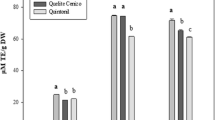Abstract
Seventy edible wild forest green leafy vegetables (GLV) collected andconsumed by tribals of Andhra Pradesh, India were analyzed for totalcarotenoids (TC) and beta carotene (BC) contents using high performanceliquid chromatography (HPLC). The vitamin A activity expressed as retinolequivalents (RE) was calculated based on in vivo conversion factorgiven by WHO. The results of the study indicated that thirty-six GLV werefound to have high vitamin A activity (0.87 to 2.34 RE) with TC and BCcontents ranging from 12.22 to 36.13 and 5.21 to 14.05 mg %,respectively; thirty GLV had moderate vitamin A activity (0.36–0.8 RE)with TC and BC contents ranging from 10.60 to 31.33 and 2.19 to 4.78 mg %.Four GLV contained low vitamin A activity (0.07–0.32 RE); – TC and BCcontents ranging from 5.12 to 13.13 and 0.40 to 1.94, respectively. Thepercent beta carotene in total carotenoids among the three groups of theGLV varied from 19.41 to 73.02, 11.11 to 46.21 and 5.98 to 37.11,respectively.
Similar content being viewed by others
References
Underwood B, McClatchey S (1994) Global prevalence of vitamin A deficiency and its control. In: Abstracts of the XVI International Vitamin A Consultative Group Meeting, Chaing Rai, Thailand. Washington, DC: IVACG Secretariat.
Baskarachary (1996) Studies on carotenoids in some plant foods as a source of vitamin A. PhD Thesis submitted to National Institute of Nutrition, ICMR, Hyderabad, India.
Food and Agricultural Organization (1993) Preventing micronutrient deficiencies: Food abundance and diversity are fundamental. Food Nutr Agric Bull 7: 8–17.
Nelis WJCF, Deleenher AP (1983) Isocratic non aqueous reversed-phase liquid chromatography of carotenoids. Anal Chem 55: 270.
AOAC (1984) Association of Official Analytical Chemists. Official Methods of Analysis, 14th edn. Arlington, VA, USA.
WHO (1982) Control of vitamin A deficiency and xerophthalmia. World Health Organisation. Technical Report Series No. 672, Report of a Joint WHO/UNICEF/Helenkeller International/IVACG Meeting. 6. Speak AJ, supinum speek Saichua andWil HP schreus (1988) Total carotenoid and beta carotene content of thai vegetable and the effect of processing. Food Chem 27: 245.
Snedecor GW, Cochran WG (1965) Statistical Methods, 5th edn. Ames, IA: The IOWA State University Press, pp 46 and 276–279.
Zakaria M, Simpson K, Brown PR, Kostulovic A (1979) Use of reversed-phase HPLC analysis for the determination of provitamin A carotenes in tomatoes. J. Chromatogr 176: 109.
Kachik F, Beecher GR, Whittaker NF (1986) Separation, identification and quantification of the major carotenoid and chlorophyll constituents in extracts of several green vegetables by HPLC. J Agric Food Chem 34: 603–616.
Heinonen MI (1990) Carotenoids and provitamin A activity of carrot cultivars. J Agric Food Chem 38: 609.
Simon PW (1990) Carrots and other horticultural crops as a source of provitamin A carotenes. Hort Sci 25: 1495–1499.
Gianopolitis CN, Vassiliou G, Vizantinopoulos S (1989) Effects of weed interference and herbicides on nitrate and carotene accumulation in lettuce. J Agric Food Chem 37: 312.
Arima HK, Amay RDB (1988) Carotenoid composition and vitamin A value of commercial brazalian squashes and pumpkins. J Micronutr Anal 4: 177.
Author information
Authors and Affiliations
Rights and permissions
About this article
Cite this article
Rajyalakshmi, P., Venkatalaxmi, K., Venkatalakshmamma, K. et al. Total carotenoid and beta-carotene contents of forest green leafy vegetables consumed by tribals of south India. Plant Foods Hum Nutr 56, 225–238 (2001). https://doi.org/10.1023/A:1011125232097
Issue Date:
DOI: https://doi.org/10.1023/A:1011125232097




